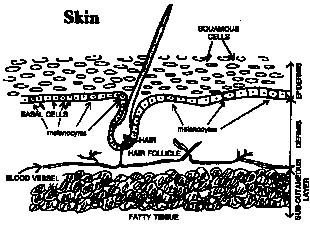
by Sharon Beder
Introduction
Human Skin Cancer
Sunscreen and Fabric
The Mouse Model of Cancer
Studies Using Skin Tissue
Drugs and Sunlight
Plant and Algae Growth
Conclusion
Glossary
Bibliography
Dr Rebecca Mason from the Department of Physiology at the University of Sydney grows skin cells in dishes in the laboratory so she can study the protective response of skin to UV light and develop artificial ways to promote that response. Professor Ross Barnetson in the Department of Dermatology at the Royal Prince Alfred Hospital is studying melanoma cells to find out why they sometimes regress so that a drug to induce regression may be developed.
One way to protect the population from sun damage by UV radiation is by encouraging people to avoid sunlight, and to use sunscreens when they can't avoid it. But there are certain occupations that make this practice difficult and, of course, people aren't always rational in their habits. So what Rebecca Mason's research is aimed at is to add to the armoury of sunscreens some kind of agent that artificially stimulates the skin's natural protective response to sunlight.
There are two protective responses that are produced as a result of going out into the sun and being irradiated with UV light. The first is an increase in pigmentation (dark colouring) which in most individuals this is what we know as a tan. The second is an increase in the thickness of the skin, particularly in the outer layer. The thickening of the skin is caused by keratinocytes or epithelial cells. These are cells in the skin which make up most of the outer part of the skin and give it the relatively tough barrier layer. These cells multiply rapidly after being exposed to UV light causing a slightly greater thickness of the outer layers.

A simplilfied diagram of some of the cells in the skin from a fact sheet published by the NSW Cancer Council.
Tanning is caused by the melanocytes or pigment cells. The pigment cells are those cells that produce the colour. When someone tans the amount of pigment produced by these cells is increased and transferred to the keratinocytes. It is not commonly understood that there are actually very few pigmentcells and if they kept all the pigment within them the tanning effect wouldn't happen. It's because they can transfer them efficiently to keratinocytes that most human skin types turn brown in the sun.
As far as is known both increased pigmentation and increased thickness are protective responses. Scientific studies of human populations suggest that people who tan, or who basically have a greater tanning capacity, are less likely to get problems with sun damage. The thickness of the epithelium, the top layer of the skin, generally means that less of the harmful radiation is able to penetrate down to other tissues. Although it is known that these things happen what isn't known yet is the identity of the chemical messengers that cause these things to happen.